The Story Behind the Photograph
How I photographed the immature King Penguins
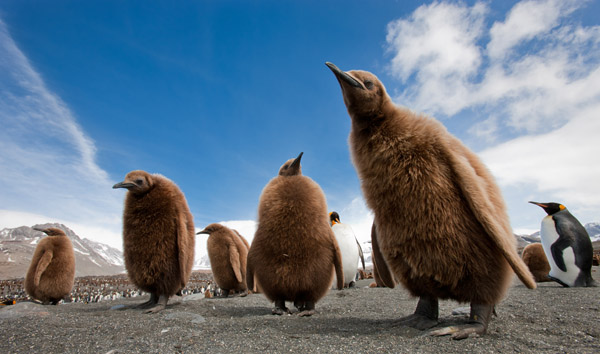
Saint Andrew's Bay on South Georgia in the south Atlantic Ocean is, in many naturalists' opinion, one of the most spectacular wildlife experiences on earth. Several hundred thousand King Penguins gather in a massive nesting colony that sweeps up from just above the high tide level on the sand and gravel beach to the tussock grass covered slopes far behind. Introduced reindeer graze in the open tundra to the right, a massive towering glacier stretches and vanishes in the distant mountains, and tons of slumbering Elephant Seals line the wave tossed beach.
Undoubtedly you've seen those images, of penguin by the thousands lining the glacial fed river, or penguin patterns of brown and black and white sweeping to the horizon. If you look at our previous trip reports you'll see we've shot those images too.
I wanted to do something different on this trip to South Georgia, so I borrowed a 14mm rectilinear fish-eye lens and also carried along my 16-35mm wide-angle zoom to try a new perspective. While the wildlife is very close in South Georgia, visitors are required to stay 15 feet away from the wildlife to avoid disturbances. That's a great rule for the human visitors, but the seals and the penguins make their own rules, and they often waddle in for a closer inspection. It's possible to simply lie down and, giving yourself a few minutes, have a penguin or three wander in to check you out.
I tried something different. After watching the penguins movements for a few minutes I placed my 16-35mm wide-angle on the sand, propped up slightly so that my field of view included plenty of sky. I attached a RPS Studio wireless remote shutter (Allen's camera sells these) to my camera's hotshoe so that I could fire the camera remotely, and then I walked away. I was carrying two cameras, and while I waited for some curious penguins I continued shooting.
It didn't take long for a group of immature or juvenile King Penguins, sometimes called mollywogs, to saunter over and inspect the shiny object on the sand. I started firing, and captured a series of shots as penguins leaned in or walked by, drawn by their curiosity.
This shot works, I believe, because I was lucky enough to have a blue sky day, adding color to the sky. Had it been overcast, as it was both before and after this session, the contrast and the dullness would have defeated the visual impact of the shot. I love doing wide-angle shots, not simply because these images often incorporate habitat or a sense of place, but also because working close requires trust on the part of the subject, and patience by the photographer. This is especially true when photographing people, as there's no way you can work within frame-filling distance of a 24mm, or less, and not be accepted and trusted. In contrast, candid portraits can be 'sneaked' by a long lens without your subject being aware, and, if he or she becomes so, you might trigger some annoyance. So getting close with a wide-angle is challenging on multiple levels, but for wildlife, where your physical presence up close might be too threatening, or dangerous or unlawful, using a remote and having some patience may be the ticket to an unusual angle or perspective. Try it!
Past Stories Behind the Photograph
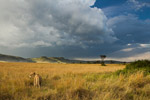

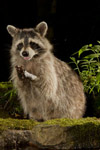
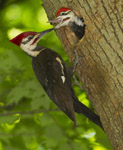


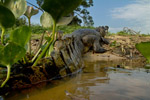
The Lion and the Landscape
The Bighorn Sheep
The Raccoon
The Pileated Woodpecker
The Striking Rattlesnake
The Pink Salmon
The Spectacled Caimen
Check out our latest web site,
mcdonaldwildlifephotos.com
where we'll be adding portfolios and eventually building up
a searchable data base for photo buyers. We've just started,
and the selection is limited, but it is still worth a visit!
Office Phone: (717) 543-6423
Or FAX us at: (717) 543-5342
The Story Behind the Photograph
How I photographed the immature King Penguins

Saint Andrew's Bay on South Georgia in the south Atlantic Ocean is, in many naturalists' opinion, one of the most spectacular wildlife experiences on earth. Several hundred thousand King Penguins gather in a massive nesting colony that sweeps up from just above the high tide level on the sand and gravel beach to the tussock grass covered slopes far behind. Introduced reindeer graze in the open tundra to the right, a massive towering glacier stretches and vanishes in the distant mountains, and tons of slumbering Elephant Seals line the wave tossed beach.
Undoubtedly you've seen those images, of penguin by the thousands lining the glacial fed river, or penguin patterns of brown and black and white sweeping to the horizon. If you look at our previous trip reports you'll see we've shot those images too.
I wanted to do something different on this trip to South Georgia, so I borrowed a 14mm rectilinear fish-eye lens and also carried along my 16-35mm wide-angle zoom to try a new perspective. While the wildlife is very close in South Georgia, visitors are required to stay 15 feet away from the wildlife to avoid disturbances. That's a great rule for the human visitors, but the seals and the penguins make their own rules, and they often waddle in for a closer inspection. It's possible to simply lie down and, giving yourself a few minutes, have a penguin or three wander in to check you out.
I tried something different. After watching the penguins movements for a few minutes I placed my 16-35mm wide-angle on the sand, propped up slightly so that my field of view included plenty of sky. I attached a RPS Studio wireless remote shutter (Allen's camera sells these) to my camera's hotshoe so that I could fire the camera remotely, and then I walked away. I was carrying two cameras, and while I waited for some curious penguins I continued shooting.
It didn't take long for a group of immature or juvenile King Penguins, sometimes called mollywogs, to saunter over and inspect the shiny object on the sand. I started firing, and captured a series of shots as penguins leaned in or walked by, drawn by their curiosity.
This shot works, I believe, because I was lucky enough to have a blue sky day, adding color to the sky. Had it been overcast, as it was both before and after this session, the contrast and the dullness would have defeated the visual impact of the shot. I love doing wide-angle shots, not simply because these images often incorporate habitat or a sense of place, but also because working close requires trust on the part of the subject, and patience by the photographer. This is especially true when photographing people, as there's no way you can work within frame-filling distance of a 24mm, or less, and not be accepted and trusted. In contrast, candid portraits can be 'sneaked' by a long lens without your subject being aware, and, if he or she becomes so, you might trigger some annoyance. So getting close with a wide-angle is challenging on multiple levels, but for wildlife, where your physical presence up close might be too threatening, or dangerous or unlawful, using a remote and having some patience may be the ticket to an unusual angle or perspective. Try it!
Past Stories Behind the Photograph







The Lion and the Landscape
The Bighorn Sheep
The Raccoon
The Pileated Woodpecker
The Striking Rattlesnake
The Pink Salmon
The Spectacled Caimen
Check out our latest web site,
mcdonaldwildlifephotos.com
where we'll be adding portfolios and eventually building up
a searchable data base for photo buyers. We've just started,
and the selection is limited, but it is still worth a visit!
Office Phone: (717) 543-6423
Or FAX us at: (717) 543-5342
The Story Behind the Photograph
How I photographed the immature King Penguins

Saint Andrew's Bay on South Georgia in the south Atlantic Ocean is, in many naturalists' opinion, one of the most spectacular wildlife experiences on earth. Several hundred thousand King Penguins gather in a massive nesting colony that sweeps up from just above the high tide level on the sand and gravel beach to the tussock grass covered slopes far behind. Introduced reindeer graze in the open tundra to the right, a massive towering glacier stretches and vanishes in the distant mountains, and tons of slumbering Elephant Seals line the wave tossed beach.
Undoubtedly you've seen those images, of penguin by the thousands lining the glacial fed river, or penguin patterns of brown and black and white sweeping to the horizon. If you look at our previous trip reports you'll see we've shot those images too.
I wanted to do something different on this trip to South Georgia, so I borrowed a 14mm rectilinear fish-eye lens and also carried along my 16-35mm wide-angle zoom to try a new perspective. While the wildlife is very close in South Georgia, visitors are required to stay 15 feet away from the wildlife to avoid disturbances. That's a great rule for the human visitors, but the seals and the penguins make their own rules, and they often waddle in for a closer inspection. It's possible to simply lie down and, giving yourself a few minutes, have a penguin or three wander in to check you out.
I tried something different. After watching the penguins movements for a few minutes I placed my 16-35mm wide-angle on the sand, propped up slightly so that my field of view included plenty of sky. I attached a RPS Studio wireless remote shutter (Allen's camera sells these) to my camera's hotshoe so that I could fire the camera remotely, and then I walked away. I was carrying two cameras, and while I waited for some curious penguins I continued shooting.
It didn't take long for a group of immature or juvenile King Penguins, sometimes called mollywogs, to saunter over and inspect the shiny object on the sand. I started firing, and captured a series of shots as penguins leaned in or walked by, drawn by their curiosity.
This shot works, I believe, because I was lucky enough to have a blue sky day, adding color to the sky. Had it been overcast, as it was both before and after this session, the contrast and the dullness would have defeated the visual impact of the shot. I love doing wide-angle shots, not simply because these images often incorporate habitat or a sense of place, but also because working close requires trust on the part of the subject, and patience by the photographer. This is especially true when photographing people, as there's no way you can work within frame-filling distance of a 24mm, or less, and not be accepted and trusted. In contrast, candid portraits can be 'sneaked' by a long lens without your subject being aware, and, if he or she becomes so, you might trigger some annoyance. So getting close with a wide-angle is challenging on multiple levels, but for wildlife, where your physical presence up close might be too threatening, or dangerous or unlawful, using a remote and having some patience may be the ticket to an unusual angle or perspective. Try it!
Past Stories Behind the Photograph







The Lion and the Landscape
The Bighorn Sheep
The Raccoon
The Pileated Woodpecker
The Striking Rattlesnake
The Pink Salmon
The Spectacled Caimen
Check out our latest web site,
mcdonaldwildlifephotos.com
where we'll be adding portfolios and eventually building up
a searchable data base for photo buyers. We've just started,
and the selection is limited, but it is still worth a visit!
Office Phone: (717) 543-6423
Or FAX us at: (717) 543-5342
The Story Behind the Photograph
How I photographed the immature King Penguins

Saint Andrew's Bay on South Georgia in the south Atlantic Ocean is, in many naturalists' opinion, one of the most spectacular wildlife experiences on earth. Several hundred thousand King Penguins gather in a massive nesting colony that sweeps up from just above the high tide level on the sand and gravel beach to the tussock grass covered slopes far behind. Introduced reindeer graze in the open tundra to the right, a massive towering glacier stretches and vanishes in the distant mountains, and tons of slumbering Elephant Seals line the wave tossed beach.
Undoubtedly you've seen those images, of penguin by the thousands lining the glacial fed river, or penguin patterns of brown and black and white sweeping to the horizon. If you look at our previous trip reports you'll see we've shot those images too.
I wanted to do something different on this trip to South Georgia, so I borrowed a 14mm rectilinear fish-eye lens and also carried along my 16-35mm wide-angle zoom to try a new perspective. While the wildlife is very close in South Georgia, visitors are required to stay 15 feet away from the wildlife to avoid disturbances. That's a great rule for the human visitors, but the seals and the penguins make their own rules, and they often waddle in for a closer inspection. It's possible to simply lie down and, giving yourself a few minutes, have a penguin or three wander in to check you out.
I tried something different. After watching the penguins movements for a few minutes I placed my 16-35mm wide-angle on the sand, propped up slightly so that my field of view included plenty of sky. I attached a RPS Studio wireless remote shutter (Allen's camera sells these) to my camera's hotshoe so that I could fire the camera remotely, and then I walked away. I was carrying two cameras, and while I waited for some curious penguins I continued shooting.
It didn't take long for a group of immature or juvenile King Penguins, sometimes called mollywogs, to saunter over and inspect the shiny object on the sand. I started firing, and captured a series of shots as penguins leaned in or walked by, drawn by their curiosity.
This shot works, I believe, because I was lucky enough to have a blue sky day, adding color to the sky. Had it been overcast, as it was both before and after this session, the contrast and the dullness would have defeated the visual impact of the shot. I love doing wide-angle shots, not simply because these images often incorporate habitat or a sense of place, but also because working close requires trust on the part of the subject, and patience by the photographer. This is especially true when photographing people, as there's no way you can work within frame-filling distance of a 24mm, or less, and not be accepted and trusted. In contrast, candid portraits can be 'sneaked' by a long lens without your subject being aware, and, if he or she becomes so, you might trigger some annoyance. So getting close with a wide-angle is challenging on multiple levels, but for wildlife, where your physical presence up close might be too threatening, or dangerous or unlawful, using a remote and having some patience may be the ticket to an unusual angle or perspective. Try it!
Past Stories Behind the Photograph







The Lion and the Landscape
The Bighorn Sheep
The Raccoon
The Pileated Woodpecker
The Striking Rattlesnake
The Pink Salmon
The Spectacled Caimen
Check out our latest web site,
mcdonaldwildlifephotos.com
where we'll be adding portfolios and eventually building up
a searchable data base for photo buyers. We've just started,
and the selection is limited, but it is still worth a visit!
The Story Behind the Photograph
How I photographed the immature King Penguins

Saint Andrew's Bay on South Georgia in the south Atlantic Ocean is, in many naturalists' opinion, one of the most spectacular wildlife experiences on earth. Several hundred thousand King Penguins gather in a massive nesting colony that sweeps up from just above the high tide level on the sand and gravel beach to the tussock grass covered slopes far behind. Introduced reindeer graze in the open tundra to the right, a massive towering glacier stretches and vanishes in the distant mountains, and tons of slumbering Elephant Seals line the wave tossed beach.
Undoubtedly you've seen those images, of penguin by the thousands lining the glacial fed river, or penguin patterns of brown and black and white sweeping to the horizon. If you look at our previous trip reports you'll see we've shot those images too.
I wanted to do something different on this trip to South Georgia, so I borrowed a 14mm rectilinear fish-eye lens and also carried along my 16-35mm wide-angle zoom to try a new perspective. While the wildlife is very close in South Georgia, visitors are required to stay 15 feet away from the wildlife to avoid disturbances. That's a great rule for the human visitors, but the seals and the penguins make their own rules, and they often waddle in for a closer inspection. It's possible to simply lie down and, giving yourself a few minutes, have a penguin or three wander in to check you out.
I tried something different. After watching the penguins movements for a few minutes I placed my 16-35mm wide-angle on the sand, propped up slightly so that my field of view included plenty of sky. I attached a RPS Studio wireless remote shutter (Allen's camera sells these) to my camera's hotshoe so that I could fire the camera remotely, and then I walked away. I was carrying two cameras, and while I waited for some curious penguins I continued shooting.
It didn't take long for a group of immature or juvenile King Penguins, sometimes called mollywogs, to saunter over and inspect the shiny object on the sand. I started firing, and captured a series of shots as penguins leaned in or walked by, drawn by their curiosity.
This shot works, I believe, because I was lucky enough to have a blue sky day, adding color to the sky. Had it been overcast, as it was both before and after this session, the contrast and the dullness would have defeated the visual impact of the shot. I love doing wide-angle shots, not simply because these images often incorporate habitat or a sense of place, but also because working close requires trust on the part of the subject, and patience by the photographer. This is especially true when photographing people, as there's no way you can work within frame-filling distance of a 24mm, or less, and not be accepted and trusted. In contrast, candid portraits can be 'sneaked' by a long lens without your subject being aware, and, if he or she becomes so, you might trigger some annoyance. So getting close with a wide-angle is challenging on multiple levels, but for wildlife, where your physical presence up close might be too threatening, or dangerous or unlawful, using a remote and having some patience may be the ticket to an unusual angle or perspective. Try it!
Past Stories Behind the Photograph







The Lion and the Landscape
The Bighorn Sheep
The Raccoon
The Pileated Woodpecker
The Striking Rattlesnake
The Pink Salmon
The Spectacled Caimen
Check out our latest web site,
mcdonaldwildlifephotos.com
where we'll be adding portfolios and eventually building up
a searchable data base for photo buyers. We've just started,
and the selection is limited, but it is still worth a visit!
Office Phone: (717) 543-6423
Or FAX us at: (717) 543-5342


